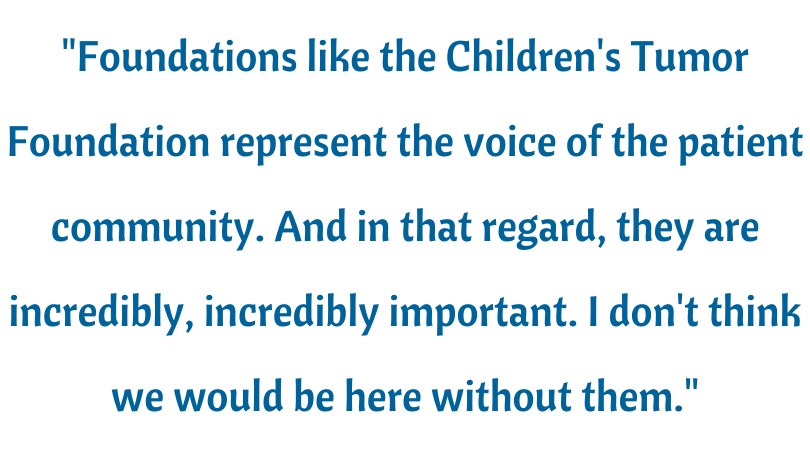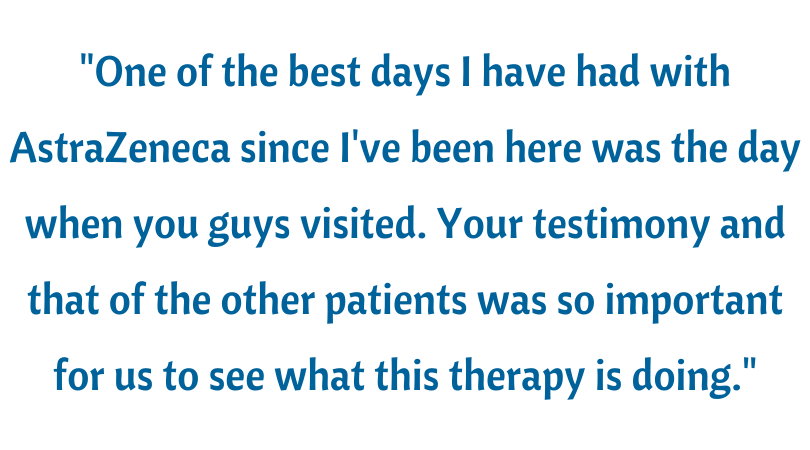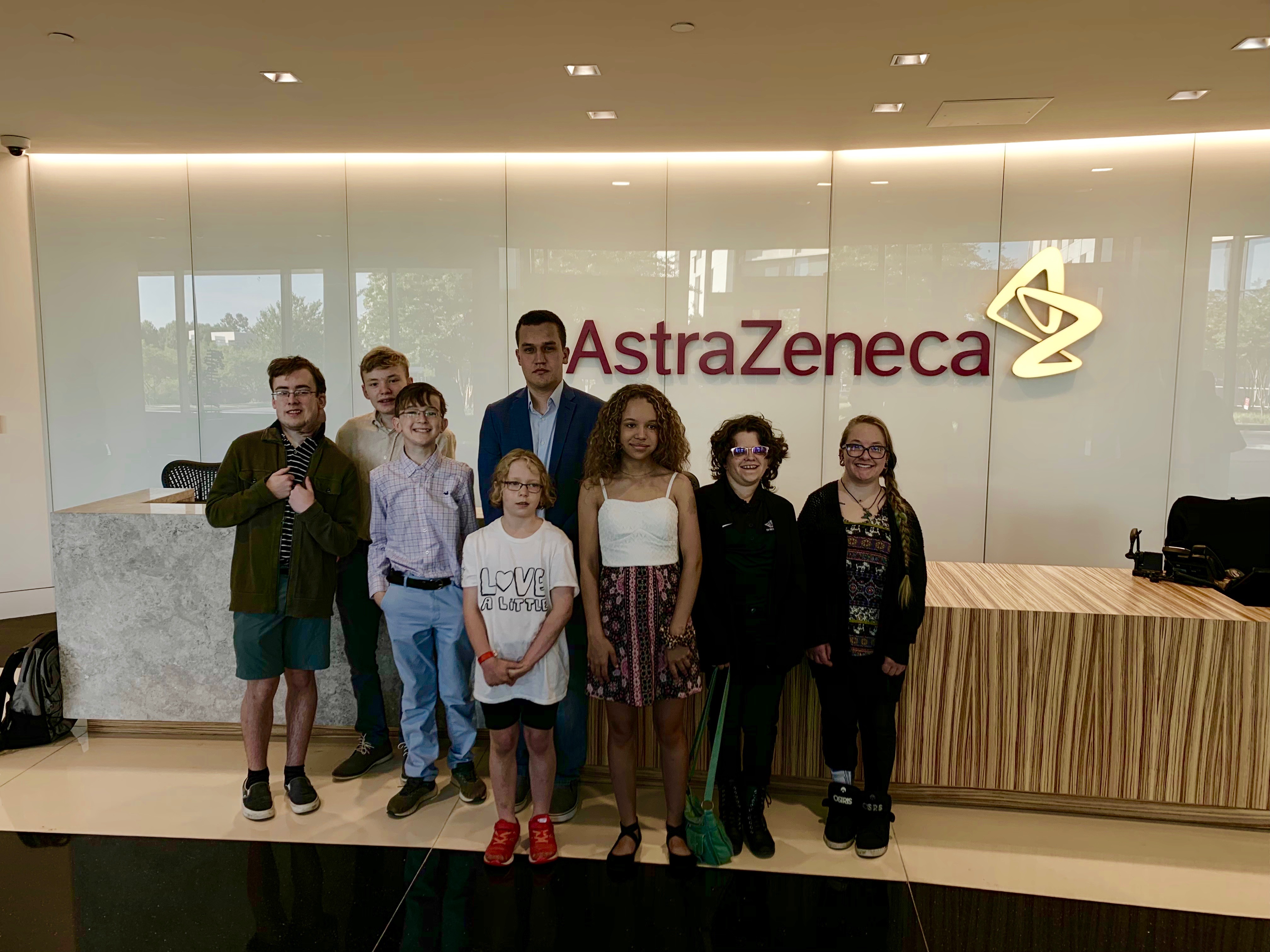Aidan Fraser, 19 years old and living with NF1, visited AstraZeneca’s corporate headquarters in Washington, DC over the summer with a group of patients and caregivers to share their stories about living with NF and actively participate on an NF1 Patient Advisory Board. This gathering was organized by the Children’s Tumor Foundation.
While at this event, Aidan had the pleasure of meeting José Baselga, Executive Vice-President, Research & Development for Oncology at AstraZeneca. Below is a summary of a conversation that took place a few weeks later.
Aidan: Why did you decide to go into oncology and rare disease?
José Baselga: When I was in medical school and I began seeing patients, I realized that there is so much need for new therapies, I felt like it was my calling. It’s a very challenging field and one in which people need help. So, I thought, “What the heck, if I do something, I might as well try to do something that will be transformative.”
I know you often talk about your passion to help patients, and also your tremendous passion for drug development.
Yes, I witnessed early on how the first, early treatments for cancer changed the lives of patients. I saw this with the anti-estrogen therapies in breast cancer and also in Leukemia when I was a student. So I thought, wouldn’t it be cool if we could develop therapies for every type of cancer?
I was very lucky – I was trained by some of the best drug developers in the world, and I just fell in love with it. I was fortunate also, because very early on in my career, I was able to develop a couple of drugs that changed the lives of so many patients. And then I was hooked. Not only did I have this passion, but also since then I’ve trained a tremendous number of people who are now doing drug development. So, I’ve been able to create and help the field by training people and by continuing to find new ways to develop drugs.
Amazing. Can you talk about what your role at AstraZeneca is?
As you know, AstraZeneca is a very large science company. We have a tremendous amount of scientists all over the world. And these guys, what they do is they identify potential new treatments for cancer, heart disease and respiratory disease. They’re working very hard in multiple areas and trying to develop new therapies. My role is to lead that effort in Oncology, not only helping with the drug target identification and then development of the new therapies, but also very importantly, answering the questions: How do we bring these treatments to patients? How do we run the clinical trials? How do we measure that a drug is safe? How do we measure that a drug is helping patients?
The moment we see that a drug is helping we work to accelerate. We launch these large clinical studies to confirm that these therapies are better than what is currently available. My role is to provide an oversight of all these activities.
Have you been heavily involved with the MEK inhibitor and selumetinib trials from the beginning?
 Yes, in my previous laboratories. It turns out that PTEN and NF1 were some of the molecules that I had studied in the laboratory for many, many years. And I had visualized the promise of these MEK inhibitors in a number of indications. And everybody in the lab thought that NF1 was a very obvious one.
Yes, in my previous laboratories. It turns out that PTEN and NF1 were some of the molecules that I had studied in the laboratory for many, many years. And I had visualized the promise of these MEK inhibitors in a number of indications. And everybody in the lab thought that NF1 was a very obvious one.
When I arrived at AstraZeneca and I saw the data, it was clear that we needed to move forward here because this could be a life-changing therapy.
Well, as somebody who was actually on the trial, I am telling you, it definitely is.
I must tell you, one of the best days I have had with the company since I’ve been here, was the day when you guys visited. I mean you, the testimony that you provided and your own experience. The whole conference room was packed and everyone was listening to you guys with tremendous interest. Your testimony and that of the other patients was so important for us to see what this therapy is doing.
Thank you very much. It was a terrific day. What do you think the hardest part of the whole of the drug discovery process is for diseases that are rare, like neurofibromatosis?
One comment, if I may, is that many rare diseases are more common than people think. A disease that affects so many, like neurofibromatosis, one in 3,000 people, that’s not that rare. We should find another name. So, that’s point number one.
Point number two is that companies have traditionally tried to develop therapies that will have a broader application to many patients. And therefore, there has been reluctance to develop a therapy that will only potentially be beneficial for a smaller number of patients. But this way of thinking is changing because, even with cancer, cancer is no longer a unified disease. Even breast cancer is no longer a single disease, but rather a conglomeration of many, many diseases that are different.
So we are changing the way we think. An example of that is the full commitment that we, as a company, have to develop selumetinib for neurofibromatosis. I think it exemplifies the commitment that we have to develop new drugs for specific diseases.
Thank you. I actually never considered that perhaps NF shouldn’t be called rare. The Children’s Tumor Foundation helped to set up the great day that you were referring to, when a group of patients came and spoke to you all at AstraZeneca. What else can organizations like the Children’s Tumor Foundation do to help accelerate the drug development process or to help companies like AstraZeneca?
Foundations can help the process by providing a voice for the patient community. As you know it is difficult to be a patient. Patients go through a lot of difficulties and deal with the daily challenges of the disease. They should have a seat at the table.
There was a moment in the history of breast cancer therapy, about 25 or 30 years ago, in which patients in the breast cancer community became activists. For the first time, I think their voice was heard – they wanted to have therapies devoted to breast cancer, therapies that were going to be useful to themselves and to family members.
So foundations like CTF represent the voice of the patient community. And in that regard, they are incredibly, incredibly important. I don’t think we would be here without them.
 I know you are constantly working incredibly hard on the drug development; do you have regular contact with patients? And does that affect how you work at all?
I know you are constantly working incredibly hard on the drug development; do you have regular contact with patients? And does that affect how you work at all?
Well, I have been treating patients since 1982, so I’ve been seeing patients myself for many, many years. And many of my colleagues at AstraZeneca have had the same experience. We are in constant contact with the patient. Every discussion that we have about a protocol, the patients are there. Every CAT scan that we see, every lab work that we analyze, the patient is there. So, I do think that we are in touch with the patient more so than anybody has a perception of, but it’s in a different way. We influence far more patients than we could if we were the attending physicians.
How do you think patients could get more involved in the process? As you know, there are many patients that are interested.
I think the first thing for patients to do is develop is awareness, to learn everything about their disease.
Second, make sure that the patient community has a seat at the table, because nobody can represent the patients as well as the patients themselves. We have gone from the concept of a patient as a passive subject in the care of their disease, which is what it has been until a few decades ago, to having the patient as decision maker of the things that need to be done, and as a partner to the research community, to the government, and to society as a whole.
I have been on the selumetinib trial for about five years. Is there anything you’d like to ask me, as a patient?
I asked when we first met and I’ll ask again – what can we do better? This requires a big discussion, because I’m sure we do a lot of things that make no sense to you. But if they don’t make sense to you, they probably make no sense to anybody! So the question is, what can we as a field and in particular as a company, do better to help you and to help the community that you represent?
A lot of people, basically everybody with NF1, is looking at the MEK inhibitor or selumetinib trial, and is very hopeful. So I feel like the best thing you could do is to get it approved by the FDA.
Most people on the trial have experienced this – that selumetinib might cause your tumor to shrink for the first two years, and then it sort of peters off and the tumor stabilizes. And I think the best thing you can all do is work towards improving the drug, so that in the future, so the tumors keep shrinking, so the drug keeps working the way it does in the very beginning.
I think that’s a very good insight. I think what we’ll need to do is to keep going. We are not a company that will get one drug approved and then just declare victory or just move on to something else. We as a company have a commitment to the diseases that we are treating. We have seen the same breast cancer, we have seen this in lung cancer, and we’re going to see this also with NF1.
That’s great to hear. You mentioned sometimes having a eureka moment. Did you have that moment when you realized that the MEK inhibitor or selumetinib was going to work to shrink tumors? Was there a moment when you realized that it could work?
So to me, it was more than a eureka moment, more like a violent realization that this was a drug that could help so many patients! I looked at the data and my reaction was, “This is unbelievable. This is the kind of thing that we have been dreaming for a long, long time.”
Did you know right away that it would be something you could bring to the FDA?
You cannot go to the FDA saying that you have a eureka moment. You need to make sure that you put together the data, and that is a much more prolonged process. But what is very clear is that what starts the process, is this initial moment in which you see the data and you say to yourself, “My God, this thing could change the lives of patients.” And that to me is the most valuable moment in the whole process.
When you’re not trying to find the cure for cancer, is there anything you like to do in
your free time?
Many things. Too many things. I play lots of tennis. I like to read. I like to walk and, most importantly, spend time with my family. And so as you can imagine, I’m not doing any of these things very well!
Well yes, you’re probably very, very busy. Which leads me to my last question: As somebody  who works on drug development on a day-to-day basis, what would you say is the best part of your day is?
who works on drug development on a day-to-day basis, what would you say is the best part of your day is?
The best part of my day is when I wake up because I think “It’s going to be a great day.” And then I start thinking, “Oh my God, what can I get done today?”
Whenever we have the results from a new clinical trial that looks promising, that’s a moment of tremendous satisfaction. It’s kind of magic. And then the other moment that it’s almost magical, is when you sit with your research teams and they show you their science – what they’re seeing in the laboratory and that’s what’s happening with a new compound. It’s better than anything else, to be sitting with scientists and physician scientists, looking at new data and visualizing what this data means and what this new therapy will bring.
Thank you so much for talking with me today.
Thank you.
Aidan pictured with all of the patients who participated in the meeting.

